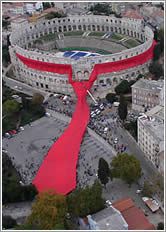
A Few Words about Croatia
To go Back at any time,
use Browser's "Previous Page"
Looking at a map of southern Europe, Croatia’s unique shape is easy to spot. Similar to a croissant, it resulted from the relentless push of the Ottomans into Europe over hundreds of years. Another unusual geographic feature is the great number of Adriatic islands Croatia has: 1185, of which only 70 are populated. Croatia shares a long maritime border with Italy to its west across the Adriatic.
Over 90% of the country’s 4.5 million people are Croat but there are also Serbian, Bosnian, Hungarian and Italian minorities. The capital and largest city is Zagreb. The official language is Croatian but use of English is widespread, especially in tourist areas. Youngsters are taught English in school from their earliest years.
Until the close of World War I, the lands that today comprise Croatia were part of the Austro-Hungarian Empire. In 1918, Croats, Serbs, and Slovenes formed a kingdom known after 1929 as (the first) Yugoslavia. After World War II, instead of a kingdom, Yugoslavia was an independent Communist state with power centralized in Belgrade under strongman Marshall Tito.
When Tito died in 1980, Yugoslavia was left without an effective leader and the country’s splintering began. Within six months of Slovenia’s vote for full independence in December 1990, Croatia followed suit. However, while Slovenia’s armed struggle with Yugoslav forces lasted a mere 10 days, Croatia’s dragged on nearly 5 years and in many ways was a brutal affair. Today hardships of the postwar years are easing with tourism, banking, and public investments leading the way. Unemployment, however, remains high.
Croatia appears to be on track to join NATO in 2008. Membership in the EU is less certain, in no small part because there is no consensus in Croatia for joining. Voters seem to be split down the middle regarding membership positives and negatives.
On lighter topics, probably not many appreciate Croatia’s contribution to fashion. That essential piece of business attire, the necktie, had its origin in Croatia, which could rightly be labeled “the mother country of the necktie.” In the 1600’s, a Croatian cavalry unit called the Royal-Cravate was in Paris to lend support to King Louis XIII. The traditional outfit of these Croats aroused interest because of the unusual, picturesque scarves distinctively tied about their necks. This elegant “Croatian style” immediately enamored the French, who were delighted by the new article of clothing, previously unknown in Europe. Thus the world discovered the “cravat,” now seen in all sorts of styles, colors, materials and sizes. The largest cravat ever unveiled was tied around the Pula Arena in 2003. It weighed 990 pounds and measured 880 yards long!
